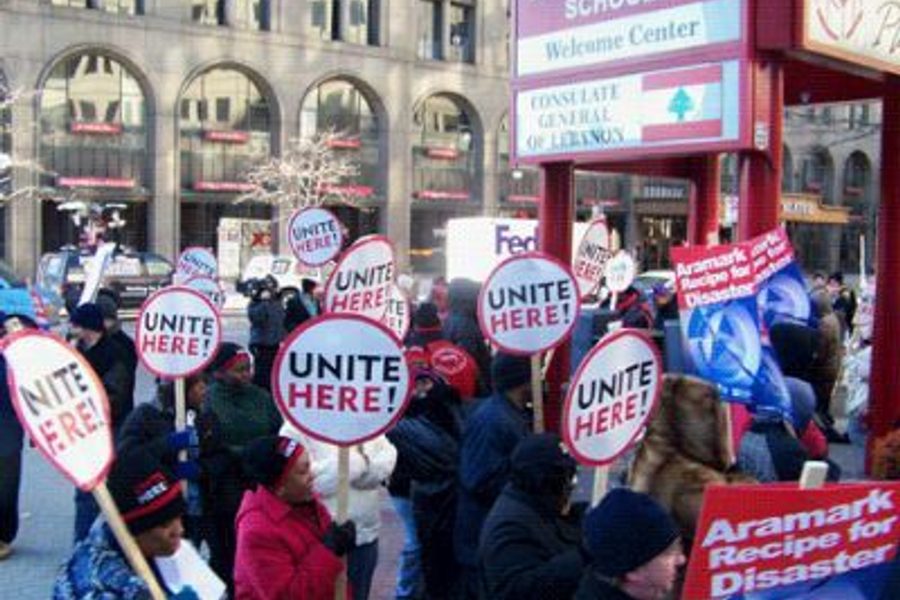
A standoff between factions of a major service worker union reveals simmering tensions over how to build union power while maintaining the labor movement’s integrity.
Since Service Workers United (SWU) emerged from an alliance between UNITE HERE and SEIU in 2005, it has campaigned heavily to organize low-wage food service workers around the country. But today, internal disputes are clouding the union’s future and raising questions about its approach to wide-scale organizing.
At the center of the dispute are gridlocked contract negotiations with the giants of the food-service sector: Sodexo, Compass, and Aramark.
In an analysis of the controversy, Paul Abowd of Labor Notes reported that advocates with UNITE HERE were frustrated that SWU had cut “secret deals” with employers, which they say ended up ceding far too much control over contracts and union activities to management:
[T]he new union traded a lot — including workers’ right to strike — for contracts in a low-wage, hard-to-organize industry dominated by the ‘Big 3.’ Aramark dropped out of the talks, but made a separate pact later that year.
To seal the unprecedented deals, contract standards were settled before the first worker signed a card. Workers faced termination if they slowed down or picketed. Conflicts over terms of the agreement would go before a national labor-management committee instead.
The companies, which have contracts to run cafeterias and concessions in schools, stadiums, and corporate offices, reserved the right to choose where the union would organize, and how many total members could join.
Sodexo capped organizing at 11,000 workers and Compass at 20,000 through 2008. Despite that, federal filings show that the union had just 6,000 members last year.
SWU, which says it has organized about 18,000 workers over the years, has sought to boost unionization throughout the sector by pushing broad contracts based on a national template.
While the “boilerplate” contracts contain some essentials, including provisions for job security and healthcare, UNITE HERE activists argue that, in terms of wages and benefits, SWU members were entitled to more but ended up having to settle for less.
Referring to the contracts as an example of “organizing by partnership,” Labor Notes quotes Jim Dupont of UNITE HERE’s Laundry and Food Service division, who previously worked as a SWU negotiator:
“SEIU’s definition of partnership is you do what the company wants,” he says. “Our definition is, you’re treated as an equal.”
SEIU, meanwhile, fiercely defends SWU’s organizing strategy, contending that the union isn’t striving merely for partnership, but scale. The idea is to build solidarity across the entire sector as a counterweight to multinational behemoths controlling the industry.
There’s a complex back story to the dispute, of course. Since UNITE HERE and SEIU split from the AFL-CIO four years ago (in tandem with other major unions) turf battles have fractured the breakaway coalition they formed, Change To Win.
This week, UNITE HERE formally declared that it is rejoining the AFL-CIO, capping off the federation’s quadrennial convention.
But, internal politics aside, the SWU controversy raises strategic questions about how unions can achieve critical mass without softening their political core.
SWU positions itself as a union that thinks big, building clout across a heavily consolidated sector. Yet its approach has invited allegations of what Dupont called “corporate unionism.”
In a conference paper on organizing strategy, UK-based labor scholars Melanie Simms and Jane Holgate compare and question two theories of unionism: the “organizing model” emphasizes collective action and organizing as a political project, outside conventional collective bargaining. The “servicing model,” meanwhile, is characterized by “passive membership,” “secretive and closed communication,” and a centralized, bureaucratic leadership.
According to Simms and Holgate, in the 1990s, the AFL-CIO under John Sweeney embodied the grassroots-oriented, organizing-centered approach, marking “a definitive shift to the left” in the American labor scene. In contrast, some U.K. unions have taken a more pragmatic corporate approach, often seeking to partner with, rather than directly challenge, employers.
Yet the authors note that union strategies today are fluid and not easily categorized, as organizers mold their approaches to “reflect their own particular contexts, histories, backgrounds and politics.”
Still, the tensions surrounding SWU may have as much to do with the politics between its parent unions as with organizing vision. In June, SWU lashed out at an “inter-union war” between UNITE HERE and the SEIU-aligned Workers United.
In a statement urging arbitration, laundry worker Maria Isabel Lozoya said: “We have to resolve the differences between our unions so that the workers will not be confused. Now who can the members turn to?”
SWU President Kurt Edelman argued, “It is a terrible thing for the labor movement to continue to be distracted, publicly tarnished, and split by this conflict.”
A political distraction or a real ideological rift? To answer that question, the labor movement first has to answer to the workers who fear their union may disintegrate before they can forge meaningful change.
Michelle Chen is a contributing writer at In These Times and The Nation, a contributing editor at Dissent and a co-producer of the “Belabored” podcast. She studies history at the CUNY Graduate Center. She tweets at @meeshellchen.








